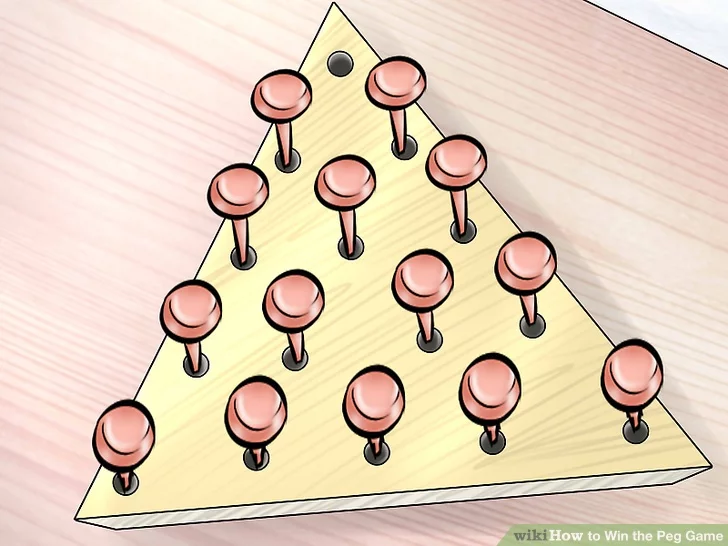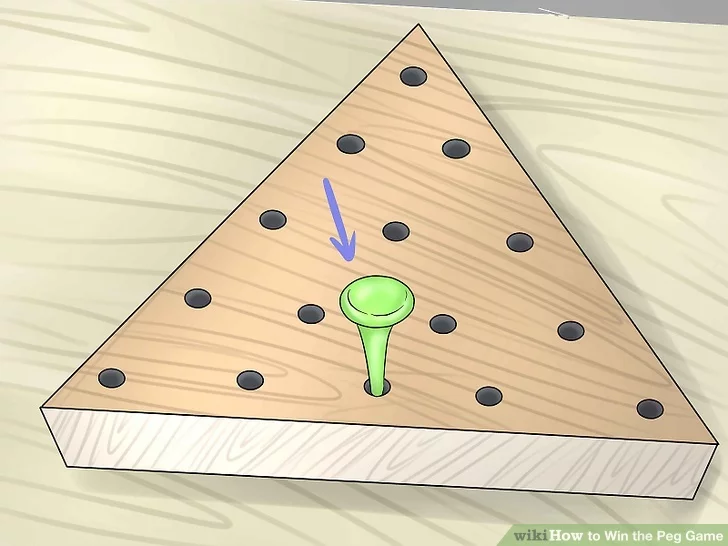CAB203 Project: Pegs
Baorong Huang: n10172912
Introduction
The classic Peg Game consists of a small wooden triangle board with 15 holes in it and 14 pegs.

The game begins with one empty hole, the player can jump a peg over another peg. The goal of the game is to jump the pegs to end up with one peg left in the game, like so:

In this report we consider a variation of the Peg Game: One-Line Peg Game.
It differs from the classic game in that the game board is a line of regularly spaced holes rather than a triangle board.
And The number of holes can vary. The game begins with some of the holes occupied by pegs, and some holes empty.
The goal of the One-Line Peg Game is, given a starting arrangement of pegs, find a sequence of jumps that
results in the board with only one peg left and all other holes empty, like so: ooXooo or determine that there is no such sequence of jumps.
Problem
We begin by describing the game rigorously. An arrangement of pegs on the board is called a state of the game.
We will represent a game state as a n-tuple of boolean variables . Note that indices start from 0 for consistency with the later implementation in Python.
Each holds a True or False value to indicate if the hole is occupied by a peg (True) of empty(False) in the position on the board.
According to this notation, a example state is given by:
The solved state is given by:
The solved state will be called and the initial state will be .
Another data structure that can be used to represent the game state is string, a string of X and o.
However, it consumes more memory and computing power.
In python, you will need 8 bits to represent a hole if it is encoded as X or o.
If the hole is encoded as a boolean value, then it only takes 1 bit to represent a hole.
In addition, a tuple of boolean values makes it easier to implement the solution.
We now describe the legal peg jumps. A player can jump a peg over an adjacent peg into an empty hole. The peg which was jumped over is removed. The player can jump left or right, but move outside of the line is not allowed.
Examining the arrangement of the 's above we can summarize which possible jumps are available as follows.
For each peg at position :
- The peg can jump left if there is a peg at position and there is an empty hole at position
- The peg can jump right if there is a peg at position and there is an empty hole at position
Now that we have described the game mechanics we can discuss the problem. Let be a graph with the set of game state.Two game states and are adjacent in if there is a legal peg jump that changes to . Note that we always remove the peg that is jumped over, we cannot find a legal jump that can go back to the previous state. Hence is directed.
The One-Line Peg Game can be summarized as follows: find a shortest path from to .
Solution
When all actions have the same cost, an appropriate strategy is breadth-first search, in which the root node/vertex is expanded first, then all the successors of the root node are expanded next, then their successors (Russell et al., 2021, p. 94). And it always finds a solution with a smallest number of actions, since when it is generating nodes/vertices at distance class , it has already generated all the nodes/vertices at distance class . Therefore, if one of them were a solution, it would have been found.
For solving the puzzle, we will calculate dynamically. There are many possible game states of this game. While this is still small enough to fit within the memory of modern computers, we will generally not need to visit all of them. Therefore, we will speed up the process and save memory by only expanding the frontier/neighbors as we take actions. We will not pre-compute the graph. This is achieved by taking a game state and apply all legal actions to it to generate its possible new game states as we traverse.
The breadth first search algorithm will produce a sequence of game states/vertices. However, the solution requires the sequence of actions.
To obtain that, I use Nodes to remember the actions, parent state and current state.
Node:
- state
- parent
- action
With these preliminaries in place, we can state the solution to One-Line Peg Game. Given the initial game state find a path
Since every vertex is a Node, the sequence of jumps is
the path from the initial node to the goal node which can be obtained by recursively traversing the parent of the goal node and reverse it.
If there is no such path, then the breadth first search will indicate so.
Implementation
A Problem class is created to model a problem. Later on,
I will create a sub-class called PegsProblem which inherits from the Problem class
as One-Line Peg Game is a special type of Problem and inheritance makes sense in this scenario .
class Problem:
def __init__(self, initial):
self.initial = initial
def actions(self, state):
"""Return the actions that can be executed in the given state."""
def result(self, state, action):
"""Return the state that results from executing the given action in the given state."""
def goal_test(self, state) -> bool:
"""Test if the state is a goal."""
After that, I define a Node class that can be used to create
nodes to store information about the game state and the parent
and the action which can transform the parent state to the current state.
In addition, I also define two important methods to discover neighbors.
class Node:
def __init__(self, state, parent, action):
self.state = state
self.parent = parent
self.action = action
def child_node(self, problem, action):
next_state = problem.result(self.state, action)
return Node(next_state, self, action)
def expand(self, problem):
return [self.child_node(problem, action)
for action in problem.actions(self.state)]
child_node is used to generate the child node of the current node after performing an action.
expand will take an instance of Problem to generate all the neighbors of the current node.
Below is the implementation of the BFS. Note that: because the problem is a directed graph it is impossible to have neighbors that we have already seen,
I could remove the if expression when extending the frontier. But I decide to keep it to make it more versatile.
# Uninformed Search algorithm
def graph_search(problem, frontier):
frontier.append(Node(problem.initial))
explored = set()
while frontier:
node = frontier.pop()
if problem.goal_test(node.state):
return node
explored.add(node.state)
frontier.extend(child for child in node.expand(problem)
if child.state not in explored
and child not in frontier)
def breadth_first_graph_search(problem) -> Node:
"Graph search version of BFS."
return graph_search(problem, FIFOQueue())
The remaining code are specific to One-Line Peg Game. The specific logic is located within PegsProblem class.
Game states are represented as tuples of booleans since we need them to be hashable to allow us to compare if two nodes are equal.
actions takes a state and return a list of legal jumps that can be performed in the current state.
Legal jumps have already been defined in Problem section.
result is a method for applying jumps and returns the state after applying the jump.
goal_test tests if there is only one True value in the state.
This is used to do an early goal test, checking if a node is the solution as soon as it is generated.
The main function is pegSolution which takes an initial state. It first instantiate an instance of PegsProblem,
then use breadth_first_graph_search(puzzle) to find the goal node.
With the goal node found, we can find all the ancestors of the goal node to construct a path to the initial state,
and then generate a list of actions, i.e. the edges connected each node.
def path(self):
"Return a list of nodes forming the path from the root to this node."
node, path_back = self, []
while node:
path_back.append(node)
node = node.parent
return list(reversed(path_back))
References
Russell, Stuart, and Peter Norvig. Artificial Intelligence: a Modern Approach, EBook, Global Edition, Pearson Education, Limited, 2021. ProQuest Ebook Central, Uninformed Search Strategies (p.94) http://ebookcentral.proquest.com/lib/qut/detail.action?docID=6563563
Note
The quality of the exported PDF is not very good. The Python code within Code Blocks are not images. The HTML version of this document can be viewed via the link below:
https://xiaohai.wiki/university/cab203-discrete-structure/project-pegs